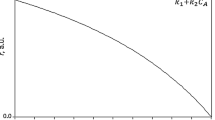Abstract
To choose the most effective process design in enzyme process development it is important to find the most effective reactor mode of operation. This goal is achieved by modeling of the reaction kinetics as a tool of enzyme reaction engineering. With the example of the transketolase catalyzed L-erythrulose synthesis we demonstrate how the most effective reactor mode can be determined by kinetic simulations. This is of major importance if the biocatalyst deactivation is caused by one of the substrates as in this case by glycolaldehyde. The cascade of two membrane reactors in series with soluble enzyme is proposed as a solution for the enzyme deactivation by one of the substrates.







Similar content being viewed by others
References
Sprenger GA, Schörken U, Sprenger G, Sahm H (1995) Transketolase A of Escherichia coli K-12: purification and properties of the enzyme from recombinant strains. Eur J Biochem 230:525–532
Zimmermann FT, Schneider A, Schörken U, Sprenger GA, Fessner W-D (1999) Efficient multi-enzymatic synthesis of D-xylulose 5-phosphate. Tetrahedron: Asymmetry 10:1643–1646
Bongs J, Hahn D, Schörken U, Sprenger GA, Kragl U, Wandrey C (1997) Continuous production of erythrulose using transketolase in a membrane reactor. Biotechnol Lett 19:213–215
Hobbs GR, Mitra RK, Chauhan RP, Woodley JM, Lilly MD (1996) Enzyme-catalyzed carbon–carbon bond formation: large-scale production of Escherichia coli transketolase. J Biotechnol 45:173–179
Sprenger GA, Pohl M (1999) Synthetic potential of thiamin-dependent enzymes. J Mol Catal B: Enzym 6:145–159
Schörken U, Sprenger GA (1998) Thiamin-dependent enzymes as catalysts in chemo-enzymatic syntheses. Biochim Biophys Acta 1385:229–243
Ward OP, Singh A (2000) Enzymatic asymmetric synthesis by decarboxylases. Curr Opinion Biotechnol 11:520–526
Turner NJ (2000) Applications of transketolases in organic synthesis. Curr Opinion Biotechnol 11:527–531
Brass JM, Hoeks FWJMN, Rohner M (1997) Application of modeling techniques for the improvement of industrial bioprocesses. J Biotechnol 59:63–72
Kragl U, Vasic-Racki D, Wandrey C (1996) Continuous production of L-tert-leucine in series of two enzyme membrane reactor. Bioproc Eng 14:291–297
Liese A, Karutz M, Kamphuis J, Wandrey C, Kragl U (1996) Enzymatic resolution of 1-phenyl-1,2-ethanediol by enantioselective oxidation: overcoming product inhibition by continuous extraction. Biotechnol Bioeng 51:544–550
Kragl U, Liese A (1999) Biotransformations, engineering aspects. In: Flickinger MC, Drew SW (eds) Encyclopedia of bioprocess technology: fermentation, biocatalysis and bioseparation. Wiley, New York, pp 454–464
Westerterp KR, van Swaaij WPM, Beenackers AACM (1993) Chemical reactor design and operation. Wiley, New York, pp 101–108
Bailey JE, Ollis DF (1986) Biochemical engineering fundamentals. McGraw-Hill, New York, pp 109–110
SCIENTIST handbook, 1986–1995. MicroMath, Salt Lake City
Woodley JM, Lilly MD (1994) Biotransformation reactor selection and operation. In: Cabral JM, Best D, Boross L, Tramper J (eds) Applied biocatalysis. Harwood, Chur
Kragl U, Kruse W, Hummel W, Wandrey C (1996) Enzyme engineering aspects of biocatalysis: cofactor regeneration as example. Biotechnol Bioeng 52:309–319
Acknowledgements
The authors gratefully acknowledge financial support from Deutsche Forschungsgemeinschaft: SFB 380 "Asymmetric synthesis with chemical and biological methods" TP B21 and C1, for part of this work.
Author information
Authors and Affiliations
Corresponding author
Rights and permissions
About this article
Cite this article
Vasic-Racki, D., Bongs, J., Schörken, U. et al. Modeling of reaction kinetics for reactor selection in the case of L-erythrulose synthesis. Bioprocess Biosyst Eng 25, 285–290 (2003). https://doi.org/10.1007/s00449-002-0312-y
Received:
Accepted:
Published:
Issue Date:
DOI: https://doi.org/10.1007/s00449-002-0312-y




